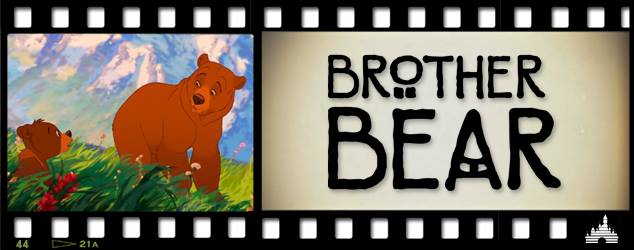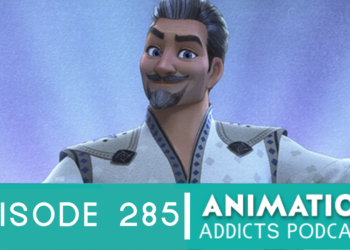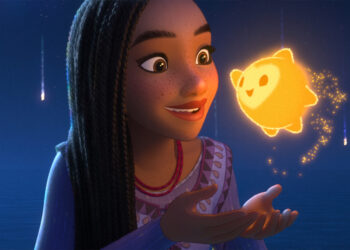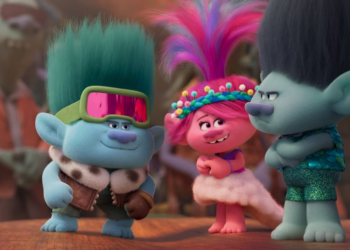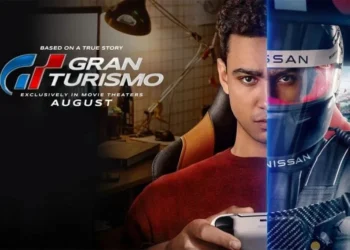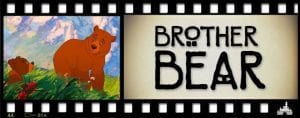
When a lion roared, a top dog barked something along the lines of “More animal stories!” That’s apparently how Disney Animation’s Brother Bear was born…
The Lion King became Disney’s highest-earning film of all time when it was released in the summer of 1994, and an all-time smash hit and world phenomenon. What was to follow? Films such as Pocahontas and the Chinese folk tale of Mulan and adaptations of The Hunchback of Notre Dame, Hercules, and Tarzan. All mainly human stories. A Lion King-esque epic with an Incan setting that involved talking llamas was also in the works, along with Fantasia Continued. No all-animal stories, though.
The plan was to essentially make the next Lion King, but the project in question would be set in North America’s wildernesses. Its look would be based on the breathtaking paintings of 19th century artist Albert Bierstadt and it would aim for a similarly massive scope. Getting off the ground in 1997, the ursus film went through several changes like many a Disney animated film from the time. It was first a King Lear story, then it evolved from there until it became the tale of an young Inuit boy’s quest to become a man.
Titled Bears by the time production went full steam ahead at Disney Feature Animation’s Florida studio in Orlando, the company and studio had changed. The roaring powerhouse that put out hit after hit – Beauty and the Beast, Aladdin, The Lion King – was stuck repeating itself until it was finally allowed to branch out with films that weren’t big Broadway musicals or your typical good-vs.-evil/love story/comedy-drama adventures. When filmmakers were allowed to do this – Michael Eisner put more executives in charge of running Walt Disney Feature Animation and named David Stainton as President of the studio – several potentially good films ended up leaving a bit to be desired. This film is one of many casualties from that era…
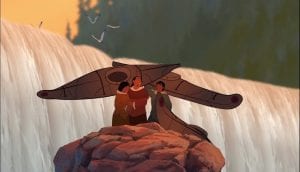
Brother Bear almost comes on like the traditionally animated equivalent of Dinosaur. Dinosaur was an ambitious film that fell victim to the executive orders that were compromising Disney Feature Animation’s then-newest features. Brother Bear, released nearly 3 1/2 years later, shows just how far things fell. Unlike Dinosaur, Brother Bear seems to have something of a functioning story with heart, whereas Dinosaur‘s story felt more like a backbone for a CGI showcase. It was that film’s writing and embarrassing dialogue that further hurt it.
The highs of Brother Bear make its lows far more frustrating. The story begins in a post-ice age Northwest. We are immediately immersed into a believable and well thought out Inuit-inspired culture. We learn about their beliefs, their system, and their ways all without much fuss. Taking from traditional Inuit beliefs, the villagers in this film believe in the Great Spirits, animal forms of their ancestors that live in the auroras that touch the highest mountains. These spirits have the power to alter the world. Tina Turner sings a great and atmospheric opening song penned by Phil Collins, though it is no “Circle of Life,” it does work. You can definitely sense that they’re trying to recapture that epic Renaissance opening gusto here. From the looks of it, Brother Bear plays out like a recapturing of the sweeping Renaissance epic, some three years after that formula was phased out.
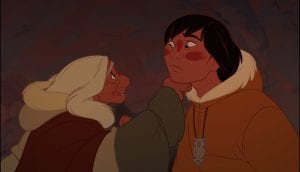
Our main hero is kind of refreshing in a way. While some bemoan Kenai for being too unlikable and too arrogant, this writer actually finds his storyline to be interesting, believable, and a bit risky. Instead of being the traditional “good” guy, Kenai is something of a jerk in Brother Bear’s first third, if not a monster. The whole story is essentially his redemption quest. He’s young and obsessed with being “a man,” your typical protagonist who wants to be viewed with respect and viewed as mature, but is too immature and ignorant to see what he or she actually needs. In Kenai’s case, it’s an honorary totem that’s bestowed upon villagers as they enter adulthood. His older brothers got the “cooler” totems, the oldest – Sitka – getting the eagle of guidance, and the middle brother – Denahi, who normally butts heads with Kenai – getting the wolf of wisdom. Kenai’s not fond of the “bear of love” totem that he gets, and is even more dismayed when a bear takes off with the fish that he was supposed to keep secure in a tree.
Not wanting to hear the end of it, he goes after the bear, and inevitably angers it. An ensuing fight gets Sitka killed. Kenai, as expected, doesn’t go about it with any consideration. Thinking that sitting around and not taking action isn’t the way to be a man, Kenai goes after the bear. This is all very strong work – the writers set up the setting’s culture, the protagonist isn’t cardboard or dull, there’s legitimate heartbreak and humor woven into the proceedings, and the picture in ways feels Renaissance-like but also unique in its own way. It has that epic Lion King exterior, but our storyline doesn’t involve a romance, or an evil towering menace that has to be stopped, or a series of specific musical numbers. All hallmarks of the majority of the 90s Renaissance films. In a way, Brother Bear tried to buck some Renaissance trends while feeling like a Renaissance movie.
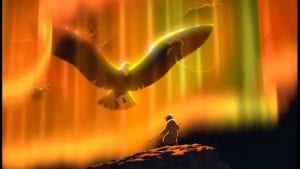
Getting his revenge and killing – yes… killing – the bear, Kenai encounters the Great Spirits. Sitka, in his eagle form, lifts him into the sky and transforms him into a bear. This is meant to make him realize what he has done, even if it takes some time for him to figure it out. The Transformation sequence is a masterpiece on its own. The film’s animation and Beirstadt-esque art direction is breathtaking, but this sequence goes one step beyond and is one of those great animated moments where it’s just something else entirely. The accompanying song compliments it.
These first thirty minutes are so brilliant, they’re so promising, but, sadly, Brother Bear stops being a great, atmospheric family film and decides to be a kiddie critter romp for the next hour. Here, the quality of the writing takes a serious dip…
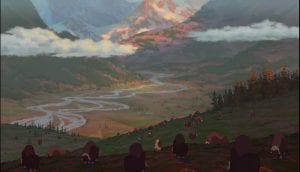
Now thankfully, the story itself stays consistent. Kenai’s quest to get back to the Northern Lights is further complicated when Denahi encounters him, not knowing that the bear in question is Kenai. He assumes it’s the bear Kenai went after, so he’s full of anger and wants revenge. I do really love this element. It shows how Denahi can also be immature and aggressive like his younger brother when ignorant to what really matters most. Again, going to back to the story of three brothers and what it means to be a “man.” Meanwhile, Kenai – being the youngest brother himself – sees what it is like to be a big brother to someone else.
At the same time, we see Kenai slowly but surely see what his actions did. There’s an effective little sequence where deuteragonist Koda looks at a cave painting of a hunter and says he sees them as monsters. Later on, after Denahi gives chase to both Kenai and Koda through a fiery Elephant Graveyard-esque pit, Kenai tries to explain that the spear-wielder isn’t a monster, ,while also insinuating that bears are monsters. Very strong stuff, and it’s all subtle and not preachy.
All of that is enough to at least keep things afloat, because when Kenai turns into a bear we get to hear what the wildlife has to say… And unfortunately it’s forced one-liners, modern talk, toilet humor, and awkward comedy all around. The tone here is so at odds with what came before and the more intense parts that are peppered throughout the second act. It’s like a road movie for the under-8 Nickelodeon crowd – we meet some random critters here and there and they’re just there to crack a joke or two. We see some dimwitted rams scream at their own echoes, two squirrels quarrel over missing nuts, a plethora of carefree bears, and so on. It isn’t like The Jungle Book, in which the characters we don’t see again are at least given full-blown sequences that really show off their personalities that in turn steal the show.
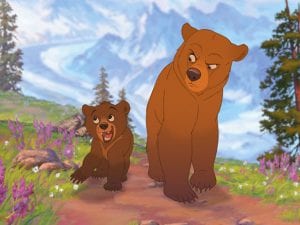
Worst of all is our deuteragonist, Koda. Koda was separated from his mother, and Kenai can’t quite figure out why, nor does he really care. Koda helps him out of a hunter’s trap, and in return Kenai reluctantly takes him to a faraway salmon run. After that, Kenai will continue looking for the mountains. Koda, like most of the animals in the movie, is not funny. He talks in modern slang and also suffers from ’90s “attitude” syndrome. Oh, and he talks. And talks. And talks… Even the film seems to think he talks too much! Animation historian Charles Solomon often wrote about how silence is one of the best forms of storytelling, and one time pointed to this very film and others as being examples that go against this philosophy.
Then there’s the moose duo, Rutt and Tuke, essentially antlered versions of Bob and Doug McKenzie – played by Bob and Doug McKenzie themselves: Rick Moranis and Dave Thomas. Now, this is a very fun idea on paper. Two Canadian comedians’ classic TV characters as moose, but that’s just it… They’re in the wrong film. They’re likable enough, but their comic relief is again at odds with the tone. Comic relief isn’t easy to nail in an animated family film, especially one that has occasional danger and drama. Walt’s films were so perfectly balanced, while the Renaissance films tended – as I said before in my review of Dinosaur here, what follows is admittedly an “in the minority” opinion – to wobble a bit in this department. Brother Bear feels like two movies haphazardly mashed into one: an atmospheric sometimes dark epic adventure and a TV movie for the Nickelodeon crowd.
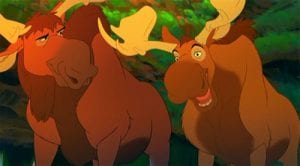
By 2003, when this movie was released, the executives that were poisoning Walt Disney Feature Animation’s creative culture felt that animated features had to be for children first and foremost. Vehicles to sell toys and Happy Meals. Animated features could no longer be storytelling greats like Walt’s films, films for both the young and old alike, or even the Renaissance-era films that brought them such big bucks. Brother Bear couldn’t be a Lion King-esque adventure that could entertain both kids and adults. No, it had to be a talky, goofy film that didn’t know whether it was a balanced Disney story, or something more in line with its straight-to-video sequels. It almost feels like the executives wanted to chase the competitors, and go for an Ice Age vibe with a slight pinch of Pixar and Shrek, but without the wit of any of these works. Blue Sky’s Ice Age knew it was a Looney Tunes-esque comedy and that’s why its modern slang and gags work despite the setting. It nailed the tone it was going for, not dissimilar to Disney’s more comedic efforts like Aladdin and The Emperor’s New Groove. DreamWorks’ Shrek knew it was an irreverent send up, which is why its dialogue does not clash with its medieval fairy tale setting. Brother Bear thinks it’s a timeless epic adventure that stays true to its time period and setting, while being consistent with the comedy and the drama… but then it decides to not be just that.
Kenai and Koda mostly bicker throughout and, when they’re not, Koda’s mostly being unfunny or we meet some random animal or two. The moose tag along, after being chased off by Denahi in one scene, so they’re along for the ride as well. When Brother Bear isn’t ping-ponging between jokey stuff and action bits, it’s throwing musical montages at us. As someone who actually likes Phil Collins’ divisive Tarzan songs, Brother Bear’s songs seem very tacked on. To be fair to Mr. Collins, I like the opening songs here, but they aren’t even sung by him. The ones he does sing? They don’t really stick the landing. “On My Way” and “Welcome” are pretty-sounding, but little else. “No Way Out” arguably should’ve been cut out of what is a very poignant sequence. (At one point, the very scene wasn’t set to have a song playing over it. You can thankfully view this in the bonus features.)
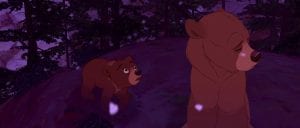
The fun-and-games tone abruptly ends when Kenai realizes that the bear he killed was Koda’s mother, leading to the very moody third act that comes in to save the picture. For the most part, it feels like we are in the film’s first third again! Everything comes together in a satisfying climax, too! I also particularly like Kenai’s selfless choice at the very end. His storyline fortunately didn’t get lost in all the critter comedy, and got a proper conclusion. But if the very belly of this film wasn’t riddled with the mood of a run-of-the-mill kids movie with needlessly modern hip talk and potty jokes, Brother Bear could’ve been a near masterpiece. It could’ve sat alongside The Emperor’s New Groove and Lilo & Stitch as a gold nugget in the pile of mud that was the early 2000s Disney Animation output. It’s squarely between the ambitious but butchered Atlantis: The Lost Empire, and the aggressively unambitious and insulting Home on the Range. Like most of the Disney animated film from this sorry era, it shows lots of potential, but it could’ve been so much more.
If not made by Disney Animation, this perhaps could’ve been seen as a lightweight tossaway trying to be a little more mature and thoughtful with its storytelling. Disney Animation, however, is much better than that. They’ve shown it time and time again, and there’s nothing wrong with a more serious story trying to work in some comedy and levity. Early films like Pinocchio, Fantasia, and Bambi were often dark and sometimes very elegant pictures, but in other moments they subtly made time for laughs. They feel just right. The Renaissance pictures, despite some valleys here and there, often kept themselves above water. Brother Bear’s first and final third are one movie, while the middle third is another.
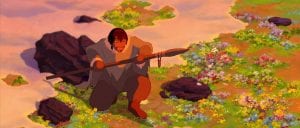
Brother Bear’s box office performance was unfairly pinned on traditional animation, but in reality it was a matter of poor timing and word-of-mouth not being as strong as it could’ve been. Disney’s ludicrous decision to open the movie wide on a Saturday (yes, you read that right – a Saturday!) kept it from opening higher than it did, and neither the legs nor the overseas gross could get it into the black. Like many a flop Disney animated film released during this era, it found a new life on home media. It must’ve done well enough, because it did get a dishonorable direct-to-video sequel! By contrast, Treasure Planet didn’t get one, and that had good video sales too. Brother Bear, I reckon, must’ve just made it.
Like its flawed brethren, Brother Bear has a sizable fanbase. I suppose they admire the film because of its hidden strengths. It isn’t a terrible movie (I myself adored it when I was 12, which is quite telling), nor is it really mediocre. Instead, Brother Bear is a Renaissance-lite Disney animated film, with the problems of that era’s output amplified times eleven. Conceived by people who were in animation for a good reason, it was nearly ruined by people who also happened to be working in animation but really should’ve been nowhere near animation to begin with. Aiming so high, yet falling so low, Brother Bear makes for a frustrating but sometimes beautiful trip through the wilderness.
Edited by: Hannah Wilkes


